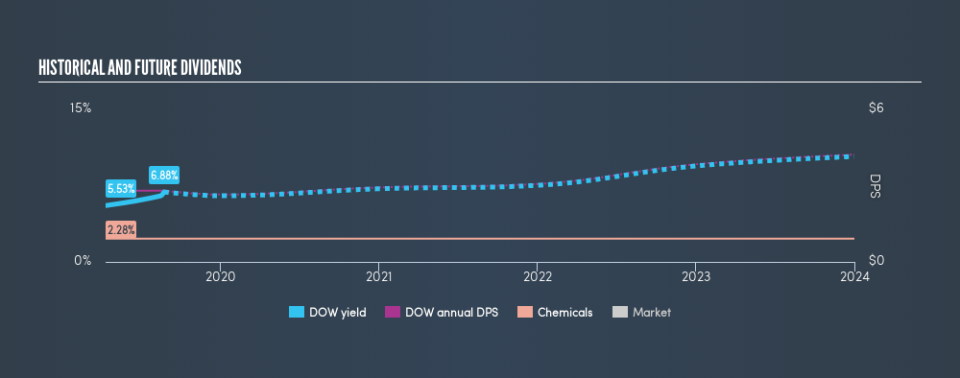Interested In Dow Inc. (NYSE:DOW)’s Upcoming 1.7% Dividend? You Have 4 Days Left

Dow Inc. (NYSE:DOW) stock is about to trade ex-dividend in 4 days time. This means that investors who purchase shares on or after the 29th of August will not receive the dividend, which will be paid on the 13th of September.
Dow's upcoming dividend is US$0.70 a share, following on from the last 12 months, when the company distributed a total of US$2.80 per share to shareholders. Last year's total dividend payments show that Dow has a trailing yield of 6.9% on the current share price of $40.71. Dividends are a major contributor to investment returns for long term holders, but only if the dividend continues to be paid. That's why we should always check whether the dividend payments appear sustainable, and if the company is growing.
View our latest analysis for Dow
Dividends are usually paid out of company profits, so if a company pays out more than it earned then its dividend is usually at greater risk of being cut. Dow paid out a comfortable 40% of its profit last year. A useful secondary check can be to evaluate whether Dow generated enough free cash flow to afford its dividend. The company paid out 109% of its free cash flow over the last year, which we think is outside the ideal range for most businesses. Cash flows are usually much more volatile than earnings, so this could be a temporary effect - but we'd generally want look more closely here.
Dow paid out less in dividends than it reported in profits, but unfortunately it didn't generate enough cash to cover the dividend. Cash is king, as they say, and were Dow to repeatedly pay dividends that aren't well covered by cashflow, we would consider this a warning sign.
Click here to see the company's payout ratio, plus analyst estimates of its future dividends.
Have Earnings And Dividends Been Growing?
Stocks with flat earnings can still be attractive dividend payers, but it is important to be more conservative with your approach and demand a greater margin for safety when it comes to dividend sustainability. If earnings decline and the company is forced to cut its dividend, investors could watch the value of their investment go up in smoke.
This is Dow's first year of paying a dividend, which is exciting for shareholders - but it does mean there's no dividend history to examine.
The Bottom Line
Should investors buy Dow for the upcoming dividend? Earnings per share have barely grown in this time, and although Dow is paying out a low percentage of its profit, its dividend was not well covered by free cash flow. It's not common to see a company paying out a limited amount of its profits yet a substantially higher percentage of its cash flow, so we'd flag this as a concern. To summarise, Dow looks okay on this analysis, although it doesn't appear a stand-out opportunity.
Wondering what the future holds for Dow? See what the 17 analysts we track are forecasting, with this visualisation of its historical and future estimated earnings and cash flow
If you're in the market for dividend stocks, we recommend checking our list of top dividend stocks with a greater than 2% yield and an upcoming dividend.
We aim to bring you long-term focused research analysis driven by fundamental data. Note that our analysis may not factor in the latest price-sensitive company announcements or qualitative material.
If you spot an error that warrants correction, please contact the editor at editorial-team@simplywallst.com. This article by Simply Wall St is general in nature. It does not constitute a recommendation to buy or sell any stock, and does not take account of your objectives, or your financial situation. Simply Wall St has no position in the stocks mentioned. Thank you for reading.

 Yahoo Finance
Yahoo Finance 
